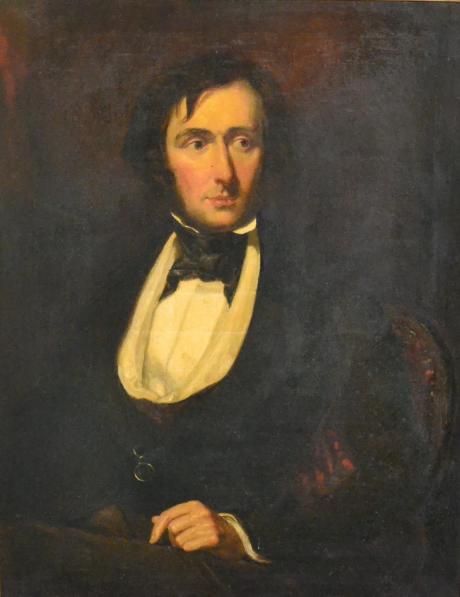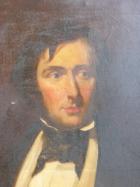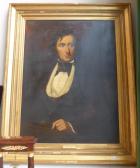Rennie, George (1791–1866), mechanical and civil engineer, was born in the parish of Christ Church, Southwark, London, on 3 December 1791, the eldest son of John Rennie (1761–1821) and his wife, Martha Ann, daughter of E. Mackintosh. He was the brother of Sir John Rennie. Educated first by Dr Greenlaw at a school in Isleworth, he then went to St Paul's School. In 1807 his father sent him to Edinburgh University, where he lodged with John Playfair, the professor of natural philosophy, and studied mathematics, natural sciences, and classics.
In 1811 Rennie entered his father's office, where many great works were in progress. He travelled extensively in Europe, particularly Italy, familiarizing himself with continental engineering and architecture. In 1818, on the recommendation of Joseph Banks and James Watt, he was appointed inspector of machinery and clerk of the irons (that is, dies) at the Royal Mint, which post he held for nearly eight years. Well before his father's death in 1821, he was assisting him in bridge design. Rennie wrote a diary of progress on Waterloo Bridge, appears to have made the theoretical calculations for the iron arches of Southwark Bridge, and claimed to have made the original design for London Bridge in 1820. His government appointment precluded him from acting as engineer to London Bridge (built in 1823–31), however, so that honour and a knighthood went to his brother John, although George wrote the description of the bridge for Cooke's Views of the Old and New London Bridges (1833). During the 1820s he designed the bridge over the Serpentine in Hyde Park and materially improved Thomas Harrison's design for Grosvenor Bridge over the Dee in Chester. He designed the stone replacement for Thomas Wilson's iron bridge at Staines (1829–32). Other civil engineering schemes reported on included a proposal for Collier's Dock in the Isle of Dogs (1824), Denver sluice (1829), and Sunderland docks (1832). Rennie married, in 1828, Margaret Anne, daughter of Sir John Jackson, bt, MP; they had two sons and one daughter.
Rennie later had considerable practice as a railway engineer, and made plans for lines to connect Birmingham and Liverpool, the Vale of Clwyd line, the railway from Mons to Manège, and the Namur and Liège Railway, of which he was appointed chief engineer in 1846. He was consulted about the Liverpool and Manchester Railway following the parliamentary failure of the first bill, and organized a new survey, giving evidence in favour of the successful scheme in 1826. Although generally associated with his younger brother Sir John, he was personally responsible for early proposals for the Midland Counties Railway (1833–6) and Central Kent Railway (1837).
Rennie's genius was chiefly mechanical. He superintended the manufacturing business of the family firm in Holland Street, Southwark, known at first as Rennie Brothers. After his brother Sir John retired from this side of the business about 1850 and George's sons, John Keith and George Banks Rennie, joined him, the firm became George Rennie & Sons and the factory was called the Albion ironworks. During its heyday a great variety of machinery was turned out, including the first biscuit-making machinery, corn and chocolate mills for Deptford victualling yard, and similar machines for the Royal William victualling yard, Plymouth. The firm also made the second tunnelling shield for Marc Isambard Brunel's Thames Tunnel (1835). Many orders for foreign governments were executed, including enormous iron dock gates for Sevastopol.
Rennie Brothers were also employed by the Admiralty in making engines for the Royal Navy, work which dovetailed with the establishment of the shipbuilding yard of J. & G. Rennie at Norman Road, Greenwich, in the 1830s. In all they supplied engines for between forty and fifty steamships for the British navy, and supplied an immense order for the Spanish government. Rennie was much interested in the screw-propeller. In 1840 the Rennies built the Dwarf, the first vessel in the British navy propelled by a screw; and they made the engines for the Archimedes, the first screw-driven vessel supplied to the Russian navy, in which Francis Petit Smith's screw was installed. Rennie was also interested in floating dry docks, for which he took out a number of patents. Locomotives were also made between 1837 and 1842, for railways in Britain, such as the London to Brighton and the London to Southampton lines, as well as overseas lines in Cuba, Austria, and Italy. But the works were found to be ill suited for manufacturing locomotives and this work was abandoned.
In 1822 Rennie was elected fellow of the Royal Society, his first paper, an account of experiments made on the strength of materials (PTRS 2, 1815–30, 118), having been written in 1817. This detailed tests on iron, timber, and stone which were among the earliest test results to be published on the strength of materials in Britain. Further papers followed, on the friction and abrasion of the surfaces of solids (PTRS 2, 1815–30, 143–70), and on the friction and resistance of fluids (ibid., 3, 1830–37, 423–42). He presented papers to the British Association of which perhaps the most important were his review papers of 1833 and 1834, Report on the progress and present state of our knowledge of hydraulics as a branch of engineering, which were reprinted as a book in 1835. He was elected a member of the Institution of Civil Engineers in 1841. In the same year his revision of Buchanan's Mills and Millwork was published.
Rennie was handicapped by physical disability, and in his latter life he appears to have been epileptic. In religion, he was a strict Presbyterian. He died of paralysis on 30 March 1866, at his London home, 39 Wilton Crescent, Pimlico, from the effects of an accident in the street the previous year, and was buried on 6 April at Holmwood, near Dorking. He was survived by his wife.
Andrew Saint and Mike Chrimes DNB
Simon Jacques Rochard, (1788–1872), miniature painter, was born in Paris on 28 December 1788, the son of René Rochard and his wife, Marie Madeleine Talon. Rochard entered the École des Beaux-Arts, Paris, on 16 November 1813 and became a protégé and friend of its president, J. F. L. Mérimée. He was first taught miniature painting by Mademoiselle Bonieu, and subsequently trained under J. B. J. Augustin (1759–1832) and possibly also under L. F. Aubry (1767–1857) and J. B. Isabey (1767–1855). In 1815 he escaped conscription by going to Brussels. There he was introduced at court, and after painting portraits of Baron Falk, minister of foreign affairs, and others he was commissioned to execute a miniature of the duke of Wellington for the king of Spain shortly before the battle of Waterloo. He made a watercolour sketch of the duke while he was engaged with his aides-de-camp, and this was the prototype of the many miniatures of Wellington that he afterwards painted. Rochard was also given commissions by English officers and other members of the cosmopolitan society then gathered at Brussels, and in November 1815 he was summoned to Spa to paint a portrait of William, prince of Orange, for his bride. The duke of Richmond—aide-de-camp to the duke of Wellington—also sat to Rochard and gave him an entrée to London society through his sister Lady Bathurst.
Based in London from 1816, Rochard established a highly lucrative practice among the aristocracy. Among his distinguished clientele he numbered Princess Charlotte of Wales (his miniatures of whom are in the Holburne Museum of Art, Bath, and in the Royal Collection), the duchess of York, the duke of Cambridge, and the duke of Devonshire; for many years he was a favourite court painter. He exhibited at the Royal Academy, the British Institution, the Society of British Artists, and at the New Watercolour Society from 1816 to 1845. In 1834 he twice painted the queen of Portugal, and in 1839, when the tsar of Russia visited England, he painted six miniatures of the tsarevich for snuff-boxes to be presented to the English noblemen seconded to the tsar's household.
In 1846 Rochard settled in Brussels, where he continued to work and exhibited at the Brussels salon from 1848 to 1869, at the Paris salon in 1852, and at the Paris Exhibition in 1867. In 1847 he printed a catalogue of the collection of pictures by the old masters which he had formed in England (Catalogue raisonné des tableaux écoles italienne, flamande et hollandaise de la collection d'un artiste, 1847), a measure of the financial rewards which he had reaped from his successful career. However, when he died, at 23 rue des Apôtres, Brussels, on 10 June 1872, his death allegedly had been hastened by the failure of Moore's Bank, in which he had invested the bulk of his savings. By his first marriage, to Henriette Petitjean, from whom he separated, Rochard had one daughter, who married an English officer; at the age of eighty Rochard married, as his second wife, Henriette Pilton, with whom he had a son and who survived him.
Though French by birth and training Rochard's work was distinctly English in style, with clear affinities to the painting of Sir Thomas Lawrence and of Sir Joshua Reynolds in terms of depth of colour and the broad, free handling with which he treated his subjects. Although Rochard's reputation declined somewhat after his death he has more recently been called ‘one of the best miniaturists of his period’ (Schidlof, 2.687). His miniatures can be seen in the Victoria and Albert Museum, London, and in the Fitzwilliam Museum, Cambridge.
François Theodore Rochard (1798–1857), miniature painter, was the younger brother of Simon Jacques Rochard. He studied in Paris before going to London about 1820, where he assisted his brother before becoming established as a fashionable miniaturist and portrait painter in his own right. He exhibited at the Royal Academy, the Society of British Artists, and the New Society of Painters in Water Colours between 1820 and 1855, and he was awarded two silver medals for his work by the Society of Artists in 1823. He lived at Foley Place, Portland Place, London, and pursued a successful career with a distinguished clientele, working in a manner very similar to his brother's, but after his marriage, to Maria, about 1850 he retired to 3 Bloomfield Villas, Shepherd's Bush, London, where he died on 31 October 1857.
V. Remington DNB



